

webgl 系列 —— 变换矩阵和动画 - 彭加李
source link: https://www.cnblogs.com/pengjiali/p/17200893.html
Go to the source link to view the article. You can view the picture content, updated content and better typesetting reading experience. If the link is broken, please click the button below to view the snapshot at that time.

其他章节请看:
变换矩阵和动画
动画就是不停地将某个东西变换(transform)。例如将三角形不停地旋转就是一个动画
和 CSS transform 类似,变换有三种形式:平移、缩放和旋转。
简单的变换用普通表达式容易实现,如果事情复杂,比如旋转后平移,这时就可以使用变换矩阵。
普通表达式
比如要平移一个三角形,只需要将三个顶点移动相同的距离即可(这是一个逐顶点操作)

用二维向量表示,就像这样:[x1, y1] + [tx1, ty2] = [x2, y2]
比如要实现如下效果:
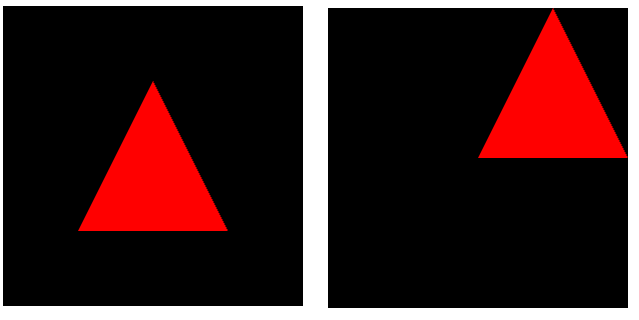
前面我们已经讲过三角形了,这里不再冗余,改动的核心代码如下:
const VSHADER_SOURCE = `
attribute vec4 a_Position;
+uniform vec4 u_Translation;
void main() {
- gl_Position = a_Position;
+ gl_Position = a_Position + u_Translation;
gl_PointSize = 10.0;
}
`
function main() {
gl.clearColor(0, 0, 0, 1);
gl.clear(gl.COLOR_BUFFER_BIT);
+ const u_Translation = gl.getUniformLocation(gl.program, 'u_Translation');
+ if (!u_Translation) {
+ return;
+ }
+ gl.uniform4f(u_Translation, 0.5, 0.5, 0, 0.0);
+
a_Position 和 u_Translation 都是 vec4 类型,使用 + 号,两个矢量(也称向量)对应的分量会被同时相加(矢量相加是着色器语言的特性之一)。就像这样:

以一个点为例,比如要将 A 点缩放到 B 点,乘以一个系数就好,系数小于1表示缩小,系数大于1表示放大:
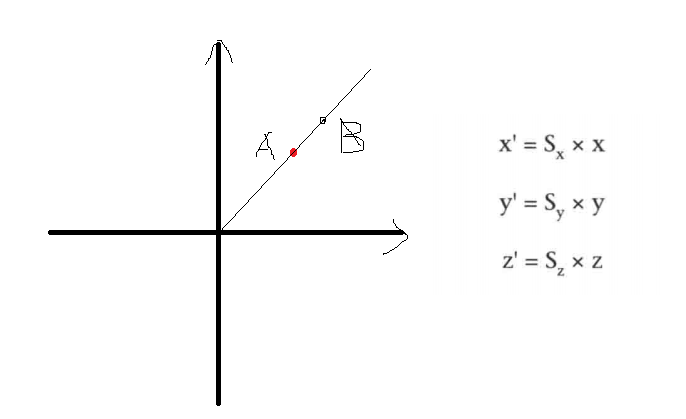
用二维向量表示,就像这样:k[x1, y1] = [x2, y2]
比如要将 p 点旋转 β,推导出来的公式如下:
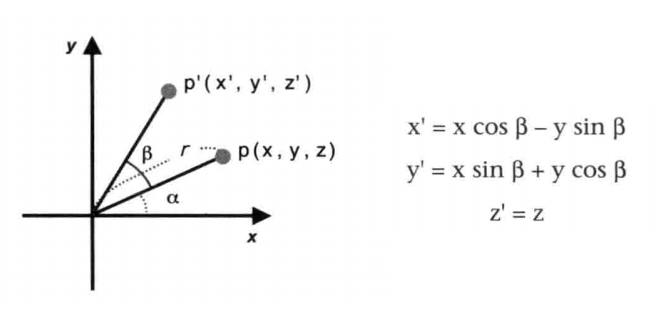
变换矩阵(非常适合操作计算机图形)是数学线性代数中的一个概念。请看下图:
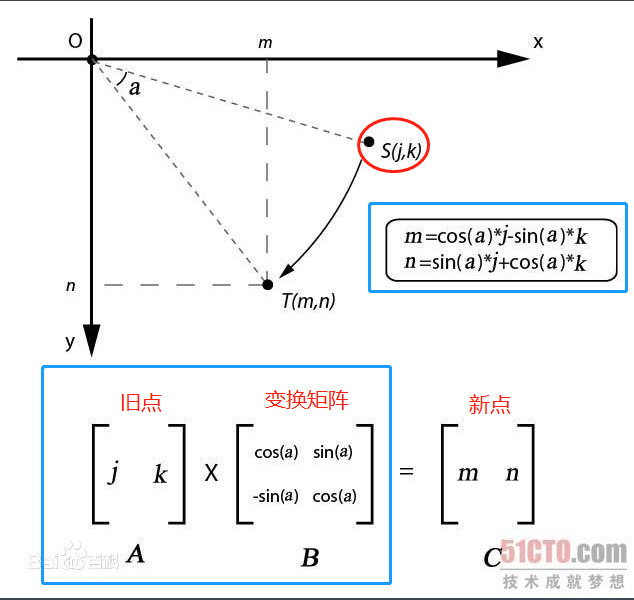
将点从 S 旋转到 T,新坐标(m, n)可以用普通表达式表示,同样可以用变换矩阵来表示(旧点 * 变换矩阵 = 新点)
变换矩阵和向量相乘有一个规则,并会得到一个新的向量。
Tip:webgl 中的一个点,在坐标系中就相当于一个向量
在 webgl 中变换矩阵和向量相乘的规则如下:

注:牢记公式:变换矩阵 * 向量 会生成一个新的向量;顺序不同结果也不同,例如:向量 * 变换矩阵
将旋转的普通表达式转为变换矩阵:

为什么要用四维矩阵?
因为三维矩阵矩阵不够用,比如将 (0,0,0) 移动到 (1, 0, 0),用三维矩阵是表示不出来的,而四维却可以。请看下图:

将平移的普通表达式转为变换矩阵:

将缩放的普通表达式转为变换矩阵:

为了更好的理解矩阵。我们先不使用矩阵库,直接通过 js 来使用矩阵实现变换。
js 中没有矩阵数据类型,这里用数组表示。
比如要表示如下一个平移矩阵:
1, 0, 0, Tx
0, 1, 0, Ty
0, 0, 1, Tz
0, 0, 0, 1
数组就是这样:
const matrix = [
1, 0, 0, Tx,
0, 1, 0, Ty,
0, 0, 1, Tz,
0, 0, 0, 1,
]
而要表示如上这个变换矩阵,在 webgl 中就得将数组颠倒:行变成列。
所以最后就得这么写:
const matrix = [
1, 0, 0, 0,
0, 1, 0, 0,
0, 0, 1, 0,
Tx, Ty, Tz, 1,
]
Tip: 对于缩放,颠倒后和颠倒前是相同的。
需求:将三角形向右上角偏移。
效果:

前面我们已经学会画三角形,笔者在此基础上改动如下代码:
const VSHADER_SOURCE = `
+// mat4 是一种4维矩阵
+uniform mat4 u_xformMatrix;
void main() {
- gl_Position = a_Position ;
+ // 注:必须是 "变换矩阵 * 向量",不可是 "向量 * 变换矩阵"
+ gl_Position = u_xformMatrix * a_Position ;
gl_PointSize = 10.0;
}
`
function main() {
initVertexBuffers(gl, vertices)
+ 变换(gl)
gl.drawArrays(gl.TRIANGLES, 0, vertices.vertexNumber);
}
+function 变换(gl){
+ const u_xformMatrix = gl.getUniformLocation(gl.program, 'u_xformMatrix');
+ if (!u_xformMatrix) {
+ console.log('Failed to get the storage location of u_xformMatrix');
+ return;
+ }
+ // 四维矩阵
+ const [Tx, Ty, Tz] = [0.5, 0.5, 0];
+ // webgl 中矩阵的行和列是要颠倒的,比如要传一个 A 矩阵,给 webgl 的A矩阵就得颠倒,也就是将 A 的第一行变为第一列,第二行变成第二列
+ const matrix = new Float32Array([
+ 1, 0, 0, 0,
+ 0, 1, 0, 0,
+ 0, 0, 1, 0,
+ Tx, Ty, Tz, 1,
+ ])
+ // 将矩阵分配给 u_xformMatrix
+ gl.uniformMatrix4fv(u_xformMatrix, false, matrix);
+}
代码解析:
- 前面已经说过,变换是一个
逐顶点的操作,每个顶点都相同,所以不用 attribute 而用 uniform mat4表示4*4的矩阵- 向量(新点) =
变换矩阵* 向量(旧点) - gl.uniformMatrix4fv(location, transpose, value) 为 uniform variables 指定矩阵值。webgl 中 transpose 必须为 false.
注:如果改变变换矩阵 * 向量的顺序,平移效果就不对了:
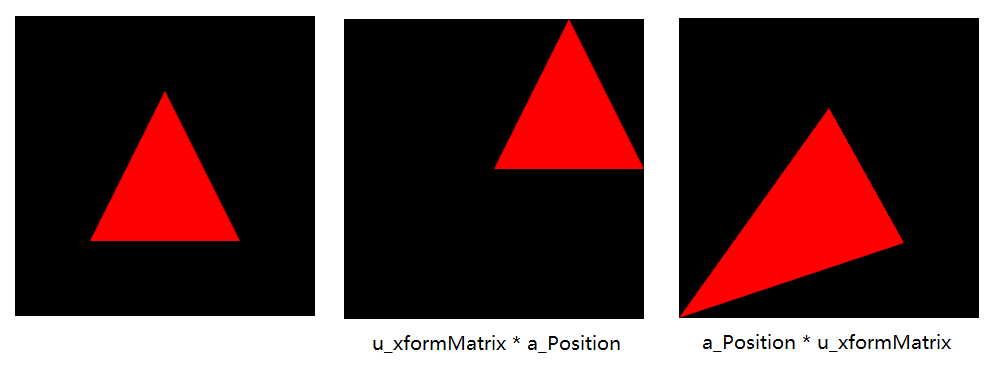
自己手写矩阵数组非常麻烦。
openGL 提供了一系列有用的函数帮助我们创建变换矩阵。例如通过 glTranslate 传入在 x、y、z 上平移的距离,就可以创建一个平移矩阵。
既然 webgl 中未提供创建变换矩阵的函数,我们就使用库来做这部分工作。
gl-matrix
笔者使用一个较流行的矩阵库 gl-matrix —— 用于高性能WebGL应用程序的Javascript矩阵和矢量(又称为向量)库。
下载后,在 dist 目录下看到 esm 文件夹和两个 js 文件:
toji-gl-matrix-4480752/dist (master)
$ ll
drwxr-xr-x 1 Administrator 197121 0 Mar 6 15:26 esm/
-rw-r--r-- 1 Administrator 197121 52466 Jan 10 05:24 gl-matrix-min.js
-rw-r--r-- 1 Administrator 197121 206643 Jan 10 05:24 gl-matrix.js
其实也就是提供两种使用的方法:
- esm 通过
<script type="module" src="main.mjs"></script>这种方式使用 - 最常见的
<script src="animation.js"></script>
笔者选用第二种:在 html 中引入:<script src="./animation.js"></script>
这时在控制台就有一个 glMatrix 全局变量:
glMatrix
{glMatrix: {…}, mat2: {…}, mat2d: {…}, mat3: {…}, mat4: {…}, …}
glMatrix: {EPSILON: 0.000001, ANGLE_ORDER: "zyx", RANDOM: ƒ, setMatrixArrayType: ƒ, …}
mat2: {create: ƒ, clone: ƒ, copy: ƒ, identity: ƒ, fromValues: ƒ, …}
mat2d: {create: ƒ, clone: ƒ, copy: ƒ, identity: ƒ, fromValues: ƒ, …}
mat3: {create: ƒ, fromMat4: ƒ, clone: ƒ, copy: ƒ, fromValues: ƒ, …}
mat4: {create: ƒ, clone: ƒ, copy: ƒ, fromValues: ƒ, set: ƒ, …}
quat: {create: ƒ, identity: ƒ, setAxisAngle: ƒ, getAxisAngle: ƒ, getAngle: ƒ, …}
quat2: {create: ƒ, clone: ƒ, fromValues: ƒ, fromRotationTranslationValues: ƒ, fromRotationTranslation: ƒ, …}
vec2: {create: ƒ, clone: ƒ, fromValues: ƒ, copy: ƒ, set: ƒ, …}
vec3: {create: ƒ, clone: ƒ, length: ƒ, fromValues: ƒ, copy: ƒ, …}
vec4: {create: ƒ, clone: ƒ, fromValues: ƒ, copy: ƒ, set: ƒ, …}
官方文档也是从这几个模块来介绍的:mat2, mat2d, mat3, mat4, quat, quat2, vec2, vec3, vec4。
mat[234]就是2维3维4维矩阵vec[234]就是2维3维4维向量
首先取得 mat4 模块,然后调用 create() 就会创建一个四维矩阵:
// 四维矩阵模块
const { mat4 } = glMatrix
// 创建一个4维单位矩阵
const matrix = mat4.create()
/*
Float32Array(16) [
1, 0, 0, 0,
0, 1, 0, 0,
0, 0, 1, 0,
0, 0, 0, 1]
*/
console.log(matrix)
Tip: create() 创建的是一个单位矩阵,如同数的乘法中的1
fromTranslation - 平移矩阵
语法如下:
(static) fromTranslation(out, v) → {mat4}
Creates a matrix from a vector translation This is equivalent to (but much faster than): mat4.identity(dest); mat4.translate(dest, dest, vec);
Parameters:
Name Type Description
out mat4 mat4 receiving operation result
v ReadonlyVec3 Translation vector
Returns:
out
请看示例:
mat4.fromTranslation(matrix, [0.5, 0.5, 0])
/*
Float32Array(16) [
1, 0, 0, 0,
0, 1, 0, 0,
0, 0, 1, 0,
0.5, 0.5, 0, 1
]
*/
console.log(matrix)
matrix 是一个单位矩阵,通过该方法,即可得到一个向 x 和 y 各平移 0.5 的变换矩阵。
与之对应不修改原矩阵的方法是:translate(out, a, v)。语法如下:
(static) translate(out, a, v) → {mat4}
Translate a mat4 by the given vector
Parameters:
Name Type Description
out mat4 the receiving matrix
a ReadonlyMat4 the matrix to translate
v ReadonlyVec3 vector to translate by
Returns:
out
请看示例:
const matrix2 = mat4.create()
mat4.translate(matrix2, matrix, [0.5, 0.5, 0])
// Float32Array(16) [1, 0, 0, 0, 0, 1, 0, 0, 0, 0, 1, 0, 0, 0, 0, 1]
/*
Float32Array(16) [
1, 0, 0, 0,
0, 1, 0, 0,
0, 0, 1, 0,
0, 0, 0, 1
]
*/
console.log(matrix)
/*
Float32Array(16) [
1, 0, 0, 0,
0, 1, 0, 0,
0, 0, 1, 0,
0.5, 0.5, 0, 1
]
*/
console.log(matrix2)
matrix 没有改变,最终变换矩阵输出到 matrix2。
fromRotation - 旋转矩阵
创建一个旋转矩阵。请看示例:
// fromRotation(out, rad, axis) - out 是要修改的矩阵、rad 旋转角度、axis 围绕哪个轴旋转 [x, y, z]
const angle = 90
// 角度转弧度
const rad = angle * Math.PI / 180;
const axis = [0, 0, 1];
// 等于 fromXRotation、fromYRotation、fromZRotation
mat4.fromRotation(matrix, rad, axis)
/*
Float32Array(16) [
6.123234262925839e-17, 1, 0, 0,
-1, 6.123234262925839e-17, 0, 0,
0, 0, 1, 0,
0, 0, 0, 1
]
*/
console.log(matrix)
与之对应不修改原矩阵的方法是:rotate(out, a, rad, axis)。用法与平移中的类似。
toRadian
旋转矩阵需要使用弧度,通过 toRadian() 可以将角度转为弧度。用法如下:
glMatrix.glMatrix.toRadian(180) => 3.141592653589793
fromScaling - 缩放矩阵
创建一个缩放矩阵。请看示例:
mat4.fromScaling(matrix, [2, 2, 0])
/*
Float32Array(16) [
2, 0, 0, 0,
0, 2, 0, 0,
0, 0, 0, 0,
0, 0, 0, 1
]
*/
console.log(matrix)
与之对应不修改原矩阵的方法是:scale(out, a, v)。用法与平移中的类似。
现在使用这个库来实现平移,只需要将手动矩阵替换如下即可:
- const matrix = new Float32Array([
- 1, 0, 0, 0,
- 0, 1, 0, 0,
- 0, 0, 1, 0,
- Tx, Ty, Tz, 1,
- ])
+
+ const { mat4 } = glMatrix
+ const matrix = mat4.create()
+ mat4.fromTranslation(matrix, [Tx, Ty, 0])
旋转、缩放也类似,不再展开。
组合变换矩阵
变换矩阵可以组合,比如希望将三角形旋转和平移,这里需要注意:顺序不同导致结果不同。请看下图

核心代码:
const VSHADER_SOURCE = `
attribute vec4 a_Position;
// 移动矩阵
uniform mat4 u_tformMatrix;
// 旋转矩阵
uniform mat4 u_rformMatrix;
void main() {
// 先旋转后移动
// gl_Position = u_tformMatrix * u_rformMatrix * a_Position;
// 先移动后旋转
gl_Position = u_rformMatrix * u_tformMatrix * a_Position;
gl_PointSize = 10.0;
}
`
const u_rformMatrix = gl.getUniformLocation(gl.program, 'u_rformMatrix');
const u_tformMatrix = gl.getUniformLocation(gl.program, 'u_tformMatrix');
const { mat4 } = glMatrix
const tMatrix = mat4.create()
const rMatrix = mat4.create()
mat4.fromTranslation(tMatrix, [0.5, 0, 0])
// 设置移动矩阵
gl.uniformMatrix4fv(u_tformMatrix, false, tMatrix);
const rad = glMatrix.glMatrix.toRadian(90)
const axis = [0, 0, 1];
mat4.fromRotation(rMatrix, rad, axis)
// 设置旋转矩阵
gl.uniformMatrix4fv(u_rformMatrix, false, rMatrix);
组合变换矩阵的顺序和 css 类似,从右往左。比如:
u_rformMatrix * u_tformMatrix * a_Position先移动后旋转u_tformMatrix * u_rformMatrix * a_Position先旋转后移动
Tip: 这里的组合变换矩阵其实就是计算机图形学中模型变换(M)。还有视图变换(V)、投影变换(P),统称为 MVP。
需求:绘制一个旋转动画
效果如下:
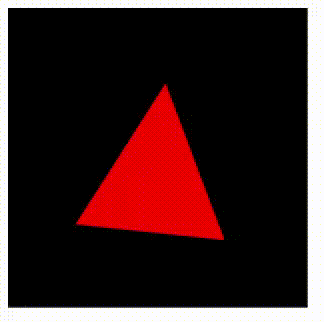
- 首先绘制三角形
- 通过变换矩阵进行旋转
- 不停的绘制(改变旋转角度)。使用专门用于动画的requestAnimationFrame(用法类似 setTimeout,但不需要指定回调时间,浏览器会在最恰当的时候回调)
完整代码如下:
const VSHADER_SOURCE = `
attribute vec4 a_Position;
// 所有顶点移动位置都相同,所以不用 Attribute 而用 uniform
// mat4 是一种4维矩阵
uniform mat4 u_xformMatrix;
void main() {
// 注:必须是 "变换矩阵 * 向量",不可是 "向量 * 变换矩阵"
gl_Position = u_xformMatrix * a_Position ;
gl_PointSize = 10.0;
}
`
const FSHADER_SOURCE = `
void main() {
gl_FragColor = vec4(1.0, 0.0, 0.0, 1.0);
}
`
function main() {
const canvas = document.getElementById('webgl');
const gl = canvas.getContext("webgl");
if (!gl) {
console.log('Failed to get the rendering context for WebGL');
return;
}
if (!initShaders(gl, VSHADER_SOURCE, FSHADER_SOURCE)) {
console.log('Failed to intialize shaders.');
return;
}
const vertices = {
data: new Float32Array([
0.0, 0.5,
-0.5, -0.5,
0.5, -0.5
]),
vertexNumber: 3,
count: 2,
}
initVertexBuffers(gl, vertices)
tick(gl, vertices)
}
function initVertexBuffers(gl, { data, count }) {
// 1. 创建缓冲区对象
const vertexBuffer = gl.createBuffer();
if (!vertexBuffer) {
console.log('创建缓冲区对象失败');
return -1;
}
gl.bindBuffer(gl.ARRAY_BUFFER, vertexBuffer);
gl.bufferData(gl.ARRAY_BUFFER, data, gl.STATIC_DRAW);
const a_Position = gl.getAttribLocation(gl.program, 'a_Position');
if (a_Position < 0) {
console.log('Failed to get the storage location of a_Position');
return -1;
}
gl.vertexAttribPointer(a_Position, count, gl.FLOAT, false, 0, 0);
gl.enableVertexAttribArray(a_Position);
}
function 变换(gl, vertices) {
const u_xformMatrix = gl.getUniformLocation(gl.program, 'u_xformMatrix');
if (!u_xformMatrix) {
console.log('Failed to get the storage location of u_xformMatrix');
return;
}
const { mat4 } = glMatrix
const matrix = mat4.create()
const rad = glMatrix.glMatrix.toRadian(angle)
const axis = [0, 0, 1];
mat4.fromRotation(matrix, rad, axis)
gl.uniformMatrix4fv(u_xformMatrix, false, matrix);
gl.clearColor(0, 0, 0, 1);
gl.clear(gl.COLOR_BUFFER_BIT);
gl.drawArrays(gl.TRIANGLES, 0, vertices.vertexNumber);
}
let angle = 0
// 每次改变的角度
const seed = 1
function tick(gl, vertices){
变换(gl, vertices)
// 改变角度
angle += seed;
// 动画绘制
requestAnimationFrame(() => tick(gl, vertices))
}
其他章节请看:
Recommend
About Joyk
Aggregate valuable and interesting links.
Joyk means Joy of geeK